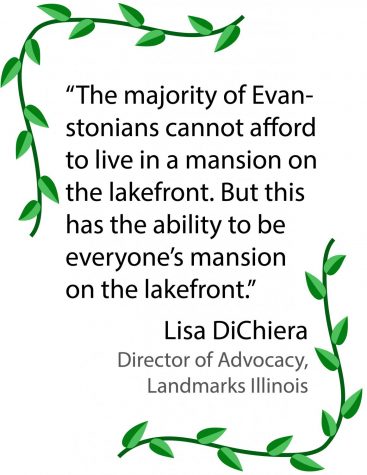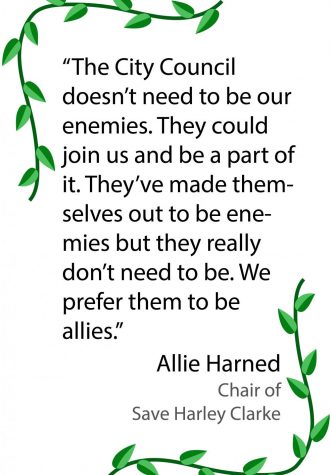In Focus: How the Harley Clarke Mansion became Evanston’s most hotly contested issue
May 20, 2019
Former 3rd Ward alderman Emily Guthrie could not believe what she saw on Election Day last November. Unlike many in the country, she wasn’t focused on the results of congressional races, but rather the outcome of an advisory referendum on whether Evanston residents wanted to preserve the Harley Clarke Mansion.
Guthrie had closed two voting locations when her shift working the polls ended that night. When she got the numbers from the first precinct, the results were undeniably positive. Guthrie was shocked.
She had worked on referenda in Evanston before — including one to save the Civic Center in 2007 — and said they usually don’t result in landslides. Some people had even rallied against putting forward a referendum to preserve Harley Clarke, saying it would fail.

Harley Clarke Mansion at 2603 Sheridan Rd. The property’s been vacant since the Evanston Art Center left in 2015.
After the results came in, she texted Allie Harned, the chair of Save Harley Clarke — the group responsible for the thousands of signs that popped up around the city before Election Day, all bearing its name as a slogan. “Are you sitting down?” she texted Harned. The precinct’s results had come in at 84 percent.
“She wrote back, ‘No, I’m jumping up and down because every precinct in town is coming in like that,’” Guthrie recalled. “And we couldn’t believe it. I couldn’t believe it. I still find it difficult to believe.”
Since the Evanston Art Center left the lakefront property in 2015, residents have fought over what to do with the mansion, but ultimately, the decision rests in City Council’s hands.
Compared to other pressing local issues — budget crises, gun violence, the school opportunity gap — one might think this would be an easy fix. In November, 80 percent of residents cast a ballot in favor of preserving the mansion and keeping it open to the public.
But it’s not so simple.
As aldermen have spent months upon months bickering about what to do with the property, it sits empty, racking up about $15,000 in yearly expenses. Businesses, nonprofits and private donors have offered solutions, but each has been rejected.
While residents vehemently disagree over the best use for the mansion — a hotel, an environmental education center, demolition to create more parkland — they all agree something needs to be done with the property.
Now, the city has once again called for bidders to offer up proposals, but aldermen can’t guarantee the next plan won’t also fall victim to the Harley Clarke curse.
“Fighting over Harley Clarke is fighting over the soul of Evanston,” Mayor Steve Hagerty said. “This is a building that’s been here for about the last hundred years.”
Built in 1927, the Harley Clarke Mansion now transcends its original purpose: a home.
The house that Harley built
Before this century, the name “Harley Clarke” was often associated with Shakespeare and movies, not a mansion on the lake.
Harley L. Clarke was a powerful Midwest utilities magnate who used his fortune to sponsor the Chicago Civic Shakespeare Society, research the educational value of movies and, eventually, build the lakefront property that remains today.
It served as a home for his family until they moved out of Evanston in 1949. Feeling the effects of the Great Depression along with years of legal battles with his former company, Clarke owed taxes on his home and had to sell it.
Sigma Chi bought the mansion, turning it into a fraternity museum and headquarters. Just like that, the mansion was no longer a home, and would never be again.
Harley Clarke Mansion is tucked away off of Sheridan Road, practically on the beach. On the outside, it doesn’t look like it belongs in this time. The six towering chimneys and elaborate stonework echo back to the decadence of the 1920s, when the ivy-covered mansion was built — a time of great wealth, flappers and Gatsby.
The backyard opens to a completely unobstructed view of Lake Michigan. With Lighthouse Beach just beyond the grass, there’s nothing but sand and waves. This is prime Evanston real estate.
Other than a couple of long-forgotten skeletons in a closet — literally and figuratively — from when the Evanston Art Center moved out in 2015, Harley Clarke is empty. While it’s not falling apart or crumbling, it’s lifeless.
No books in the library. No seating in the living room. No art in the old gallery spaces. Its surfaces are all coated in dust, while cobwebs line the grand spiral staircase in the foyer. The lights in the basement no longer work. There are exposed wires, patches of peeling paint and holes in the walls.
To make a house a landmark
The 37,700-square-foot estate is one of the last of its kind, a three-story lakefront mansion built before the 1929 stock market crash.
Chicago Tribune architecture critic Blair Kamin called the mansion a “rare architectural gem” in a 2018 column. Kamin told The Daily the mansion’s interiors and rare stonework are what distinguish it from modern lakefront mansions.
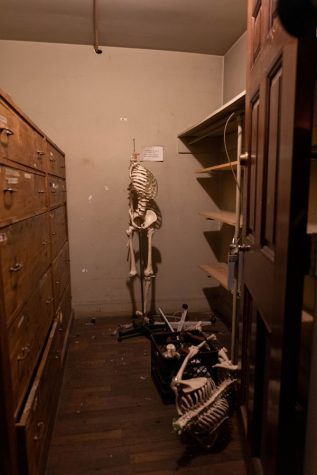
Skeletons left over from the Evanston Art Center sit in a closet of the Harley Clarke Mansion.
Danish landscape architect Jens Jensen was famous for redesigning Chicago’s open green spaces in the early 20th century. He and architect Richard Powers conceptualized the mansion’s grounds and building, respectively.
“It’s valuable architecturally and socially,” Kamin said. “It’s the only mansion along Evanston’s lakefront that’s open to the public. So it gives grand access like this to people who can’t afford to live in one.”
The mansion, added to the National Register of Historic Places in 1976 and made a National Historic Landmark in 1998, anchors the Northeast Evanston Historic District on Grosse Point.
The house’s significance has little to do with Clarke himself, said Lisa DiChiera, the director of advocacy at Landmarks Illinois, a nonprofit seeking to preserve state buildings and spaces.
“It’s not so much that the building should be (an) homage to him — there’s a lot of wealthy famous people who were successful in business and life who lived in Evanston,” DiChiera said. “It’s about the quality of the design, the quality of the architecture. Homes like this, you could never build again today.”
When Sigma Chi moved out in 1965, it sold the mansion and its land to the city for $750,000. Evanston planned to extend the public beachfront, but ended up leasing it to the Evanston Art Center for a symbolic $1 a year. By taking control of the mansion and essentially making it public property, the city set off the current cycle of indecision.
‘A terrible landlord’
In 1966, the mansion was made public for the first time and the Evanston Art Center officially moved in. According to the Chicago Tribune, 1,500 guests attended the ribbon-cutting that kicked off the art center’s near 50-year run hosting classes and gallery showings.
Carlis Sutton, whose family has lived in Evanston since 1913, said the art center’s opening gave residents unprecedented free access to the lakefront.
Sutton was a teacher at multiple schools in the Evanston/Skokie School District 65. For field trips, he said he’d bring his students to the art center, where they had the opportunity to eat lunch on the lawn, work on painting projects and experience the lakefront, something many of them weren’t often able to do.
He called the trips some of the best outings teachers could give their students.

Harley Clarke Mansion’s exterior grounds. Some residents have supported proposals for the mansion that would lead to more open green space.
Problems arose, though, when neither the art center nor the city kept up with part of their lease agreement: maintenance. The lease stipulated that the city was responsible for exterior repairs while the art center was responsible for the upkeep of the interior — but a 1977 city report showed neither happened.
The landscape around the house, the report said, was “largely neglected” and the city needed to think about future uses for the space.
Decades later, city officials are feeling the repercussions of their predecessors’ oversight.
Guthrie, who has also served on the Evanston Preservation Commission, said if the necessary money had been put in by the city and the art center to maintain the structure, Harley Clarke would need less rehabilitation today.
“The city really is a terrible landlord,” Guthrie said. “They just weren’t paying any attention. They signed the lease and then kind of walked away.”
Ultimately, nothing was done until Wally Bobkiewicz became city manager a decade ago, and he said aldermen started to express concerns to him about incomplete building maintenance.
So, as the council began budget discussions in 2011, Bobkiewicz identified three possible facilities aldermen could consider repurposing to save money. Of those properties, Harley Clarke received the least public support.
Since that night, the future of Harley Clarke Mansion has been uncertain. But unlike today’s City Council meetings, there was an absence of widespread public comment in support of the mansion. In fact, it wasn’t until 2013 that people began coming to the meetings in droves to speak about Harley Clarke.
“It’s been interesting to me observing all of this, going from that point where the name Harley Clarke Mansion was never even attached to the building — it was just the plain old Evanston Art Center — to where we are today, that many people feel this is a singular cultural icon,” Bobkiewicz said. “That was not on anyone’s radar screen ten years ago.”
For the past six years, residents have been divided on the future of the property because of its versatility. At the same time, the council has struggled to act.
The art of no deal
To its credit, City Council has tried. But nothing’s worked.
In 2015 — the year the art center officially moved to its current location on Central Street — the city formed the Harley Clarke Citizens’ Committee to identify potential uses for the newly vacated mansion. Chaired by Hagerty, who was not mayor at the time, the committee held eight public meetings, made an email account to collect public comment and conducted a community survey.
The group found no public consensus about what to do with the mansion.
The committee identified five potential options for the mansion: retain and renovate for public use, demolish, sell for commercial use, sell to a residential developer, or sell or gift the building for restoration and public use. Every avenue, except selling to a residential developer, has come before the council.
The members agreed selling the building and land for residential development was the least desirable option, and said the building needs to be financially self-sustaining to lower city spending. Hagerty said he still believes the most feasible option for the mansion is private investment, such as a hotel or restaurant.
But in 2013, retired Army Lt. Col. Jennifer Pritzker of the billionaire Pritzker family presented such a plan — and it failed. The former Evanston resident offered to buy the property for $1.2 million and develop a 57-room boutique hotel with parking, restaurant and event space.
The debate began. Residents formed an opposition to the Pritzker proposal and put up yard signs saying, “Parks are for People, Not for Profit.” Though some residents appreciated that with Pritzker’s plan, the property could have “come back to life” with investment, DiChiera said many advocates opposed privatization of a public building.
Hundreds packed the council chambers on July 22, 2013 to show their disapproval, The Daily reported. Within the meeting’s first 20 minutes, aldermen denied the proposal 6 to 3. The council needed a new option.
Pandora’s box
In 2014, Bobkiewicz hoped to enter into a long-term lease with the Illinois Department of Natural Resources, which planned to renovate the mansion and convert it into an office space and coastal management education center, city documents show.
Former 7th Ward alderman Jane Grover told the Evanston Roundtable at the time that the proposal “checked all my boxes” and its falling through would open “the Pandora’s Box of Harley Clarke.”
With the election of Republican Gov. Bruce Rauner, the plan did fall apart. Bobkiewicz’s contact at the IDNR left, while the state’s budget would soon enter a nearly three-year stalemate.
And so, Pandora’s Box opened.
Formed in December 2015, the nonprofit group Evanston Lakehouse and Gardens sought to find a solution for the property that would restore the mansion, make it financially self-sustainable and provide public access to the lake.
Tom Hodgman, the former president of Evanston Lakehouse and Gardens and current board member, said he and other members of the group decided to form a nonprofit to restore the structure after the Pritzker and IDNR plans failed.
In November 2016, the city formed the Harley Clarke Planning Committee, chaired by Ald. Eleanor Revelle (7th), to discuss next steps and recommend a future use for the mansion to the council.
Evanston Lakehouse and Gardens proposed a community space that would provide experiential environmental education, outdoor recreation and events. The group also suggested renting out parts of the property to small businesses to produce revenue.
After going through the committee process and being the sole respondent to the council’s request for proposal period, Evanston Lakehouse and Gardens eventually began negotiating a lease with the city in November 2017.
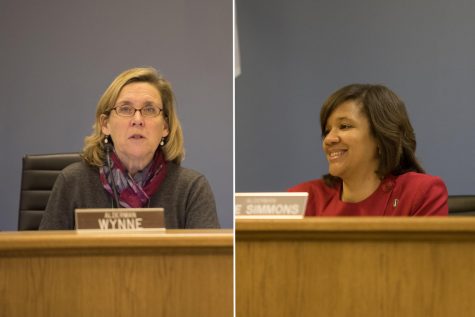
Ald. Melissa Wynne (3rd) and Ald. Robin Rue Simmons (5th). The two were among the aldermen who did not vote to approve the Evanston Lakehouse and Gardens agreement.
City staff and the nonprofit came up with a 40-year lease that would have required Evanston Lakehouse and Gardens to raise $2 million over the first three years of the agreement to fund improvements to the structure, adding up to a total of $5 million over 10 years. According to the plan, the mansion was expected to open to the public in May 2023.
But then, on April 9, 2018, the council suddenly denied the lease after months of negotiations. Only Revelle and Ald. Tom Suffredin (6th) voted to approve the agreement, while the other aldermen cited potential problems.
At the time, Ald. Robin Rue Simmons (5th) said she had concerns about donor fatigue, and Ald. Melissa Wynne (3rd) said there were insurance issues that posed a “significant risk” to the city. Wynne added that the 10-year time frame to raise $5 million would have had to be shortened for her to support the lease.
Unofficial estimates for renovation range from $400,000 to get the mansion up to safety codes, to $10 million for a complete refurbishment, DiChiera said.
Lori Keenan, an Evanston resident who has been involved with efforts to save the mansion since 2013, said Evanston Lakehouse and Gardens learned a few days before the vote that the council was not going to accept the lease. She said members tried to reach out to aldermen before April 9, but could not “make any headway.”
Revelle said if she could go back and redo the negotiations, she would.
“I don’t know if it was miscommunication, exactly,” she said, “but it was just an unfortunate way the whole conversation evolved.”
Evanston Lakehouse and Gardens had also learned that another group of residents had formed months before the vote and had been lobbying aldermen to consider a much different course of action: demolition.
The case for demolition
Jeff Coney, who was a member of Evanston Lighthouse Dunes, said roughly 10 people came together to form the group in fall 2017. The group aimed to demolish the mansion, create more green space and open up the lakefront.

Ald. Ann Rainey (8th). Rainey was supporting Evanston Lighthouse Dunes’ demolition effort.
Coney said he didn’t believe donors would have been willing to fund renovations and wanted the opportunity to add parkland.
Just weeks after the council denied the Evanston Lakehouse and Gardens proposal, Ald. Ann Rainey (8th) requested that aldermen consider the alternative from Evanston Lighthouse Dunes after the group said they had secured necessary funding for demolition.
The group of about 100 donors included former aldermen like Delores Holmes and current aldermen like Rainey, and raised about $400,000. At the meeting, Evanston Lighthouse Dunes member Nicole Kustok said the group’s vision was to restore the Jens Jensen gardens. They also wanted to return the dunes to their natural state and use the two fog houses as environmental labs and classrooms.
Emails released by the city show members of the Dunes group had been communicating with aldermen about their demolition idea in 2018, before the vote on Evanston Lakehouse and Gardens’ lease. In the emails, the Dunes group also expressed concerns over whether Evanston Lakehouse and Gardens could meet fundraising goals in a reasonable timeframe.
Some Evanston Lakehouse and Gardens members said the Dunes group was primarily serving the interests of immediate neighbors to the mansion.
In the emails, Rainey said she received at least 100 emails saying demolishing the “asset at the behest of a small group of wealthy neighbors is antithetical” to the values of Evanston.
Coney said the idea the Dunes group was just serving a small group of wealthy neighbors was “bullshit.”
“We had the ex-mayor of Evanston; we had ex-aldermen on our support group,” Coney said. “We had people from a lot of wards. The donor list speaks for itself.”
The case for equal access
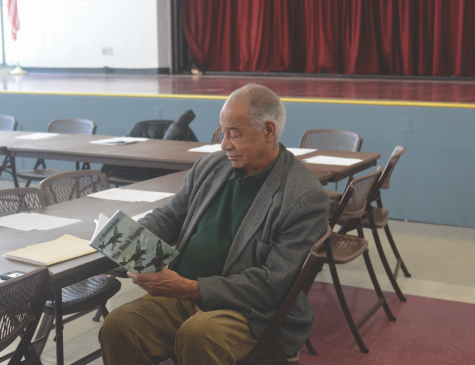
Longtime civil rights activist Bennett Johnson. He feels opening the mansion to everyone in Evanston should be a priority.
Many got involved in the effort to save Harley Clarke because there is limited access to the lakefront in Evanston: Private houses line the North Shore and the beaches require tokens, which prevents many low-income residents from visiting the lake.
At a recent City Council meeting, longtime civil rights activist Bennett Johnson emphasized the importance of opening the mansion to everyone in Evanston. He said he grew up next to Harley Clarke, yet was forced to attend a school far from the 7th Ward, where the mansion lies.
“As most of you know, the lake has been a white haven… for many, many decades,” Johnson said during a public comment period. “We have to do something about the public component and make sure every citizen of Evanston has access to this particular site.”
He said he wants the council to clarify what role the public will have in the process as aldermen decide what to do with Harley Clarke.
If the city or an organization were to provide free, public access to the lake through Harley Clarke, Sutton said, Evanston would make a small step toward equality.
DiChiera said the mansion is a “gift” to the public that needs to be invested in and maintained.
“The majority of Evanstonians cannot afford to live in a mansion on the lakefront,” DiChiera said. “But this has the ability to be everyone’s mansion on the lakefront.”
An uphill battle
In June 2018, aldermen voted 6-3 to move forward with demolition negotiations and a month later, voted 5-3 to approve the demolition.
The released city emails also showed Rainey was supporting Evanston Lighthouse Dunes’ demolition effort. Her actions prompted an October Ethics Board investigation, which found her in violation of the ethics code. Rainey was not disciplined.
Some, like Evanston resident Darlene Cannon, said the ethics violations and the rejected Evanston Lakehouse and Gardens lease after months of negotiations undermined her perceptions of the council.
“I didn’t see what was supposed to be democracy taking place,” Cannon said. “I didn’t feel it was a fair and democratic process.”
A few days after the vote, Harned filed a petition to put a referendum on the mansion on the November ballots. This was when Evanston Lakehouse and Gardens’ Political Action Committee arm, Save Harley Clarke, formed.
When the referendum was up for vote in November, 80 percent of residents were in favor of preserving the mansion for public use, a result that is not legally binding. A month before, the Evanston Preservation Commission — which said the city did not meet any of its five standards for demolishing a public landmark — had also unanimously denied the city’s application to tear down the mansion.
Demolition was suddenly an uphill battle for the city. Not wanting to go through the process of appealing the Preservation Commission’s decision, aldermen unanimously reversed their own decision to tear down Harley Clarke in December.
“I think some of my colleagues thought that trying to pursue demolition in the face of that denial from the preservation commission was yet another hurdle that wouldn’t be productive,” Revelle told The Daily.
After the vote, Hagerty lamented that the city had come full circle. A commercial lease? Rejected. A nonprofit lease? Rejected. Demolition? Rejected. Everything, he posited, had been tried.
Now, the city is back where it was in 2015, when the art center first moved out. On Thursday, Evanston officially started its third request for proposals period. The question now is whether this time, the proposal the council accepts will meet the same fate as the others.
One last push?
This time around, there’s one difference — residents are already organized.
Currently, there are several groups that support preservation: Friends of Harley Clarke, Harley Clarke Community, as well as Evanston Lakehouse and Gardens and Save Harley Clarke.
Some of them, like Harley Clarke Community, are focused on community engagement, but member Cannon said the group will consider supporting and raising money for a proposal in the future.
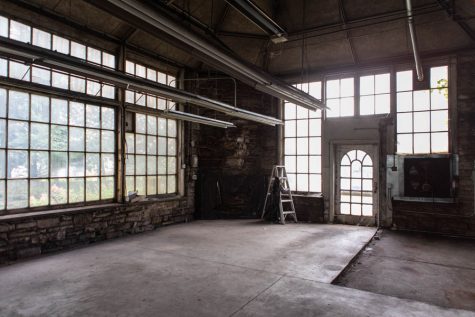
Harley Clarke Mansion’s interior. Evanston residents are organizing to decide what to do with the building.
Evanston Lighthouse Dunes has disbanded. After the vote, they all went back to their day jobs, Kustok said.
“There are other groups who wish to save the house,” Kustok said in a statement. “And, while we support the desire — ideas have never been in short supply.”
Evanston Lakehouse and Gardens is still involved in the process, and some Harley Clarke Community members have joined them. Guthrie — the current president of Evanston Lakehouse and Gardens — said the group plans to seek funds, make some changes to their proposal and present again. She said it’s important for the various groups to focus on different aspects of the property, such as the Jens Jensen gardens or the mansion itself, so donors can support distinct ideas.
“We all have to carve out an area so we can distinguish ourselves from each other,” Guthrie said. “We just have to find a way to all work together out there, talking about all the various aspects and trying to find a couple million bucks right off the bat.”
Keenan said Friends of Harley Clarke is in the process of reorganizing and determining how to best support preservation and the future use of the property. She added that the group will back any proposal that satisfies the referendum.
Harley Clarke Community, which has held meetings on possible uses for the mansion, will hold a community forum to go over the new RFP with residents, Cannon said, and collaborate with another group to write a response.
Save Harley Clarke, originally established to lobby for the referendum, decided not to disband in case demolition ever came back on the table. Since November, Harned said the group has been focused on gathering community members’ ideas on what the property should become.
After compiling information from those meetings, Harned said the group will present a report to City Council.
“We’re trying to be proactive and keep the city aware of the results of the referendum and what the referendum mandated,” Harned said. “We want it to be for public use and obviously at little or no cost to the taxpayers.”
While the groups may not be in full collaboration or all support the same proposal in the end, their fight is not with each other.
Members of different organizations have stressed that overall, the residents and the city need to come together around a decision for Harley Clarke.
“The City Council doesn’t need to be our enemies,” Harned said. “They could join us and be a part of it. They’ve made themselves out to be enemies but they really don’t need to be. We prefer them to be allies.”
Email: samanthahandler2021@u.northwestern.edu
Twitter: @sn_handler




